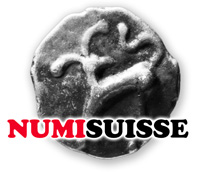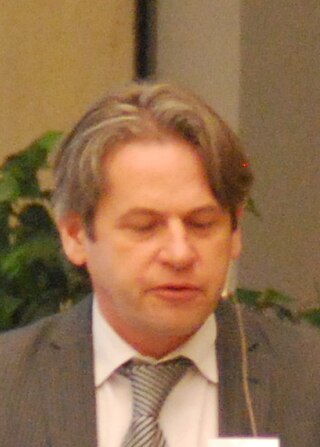Related Research Articles

Numismatics is the study or collection of currency, including coins, tokens, paper money, medals and related objects.

Professor Ya'akov Meshorer was the Chief Curator for archaeology at the Israel Museum in Jerusalem and a prominent Israeli numismatist.

The Swiss Numismatic Society was founded in 1879 and is a registered non-profit organization. It is the overall Swiss association of individuals and institutions with an interest in ancient and modern numismatics.

Ernest Charles François Babelon was a French Numismatist and classical archaeologist.
Agnes Baldwin Brett was an American numismatist and archaeologist who worked as the Curator at the American Numismatic Society from 1910 to 1913. She was the first paid curator at the American Numismatic Society. She made important contributions to the study of ancient coinage, medals, and sculpture, whose work was used by later archaeologists. Brett was also a visiting lecturer of archaeology at Columbia University in 1936.

François de Callataÿ is a Belgian ancient historian, professor at the École pratique des hautes études (Paris/Sorbonne), who has written significant studies of coinage and finance in the ancient Mediterranean world.
A numismatist is a specialist in numismatics. Numismatists include collectors, specialist dealers, and scholars who use coins and other currency in object-based research. Although use of the term numismatics was first recorded in English in 1799, people had been collecting and studying coins long before this, all over the world.
Georges Charles Le Rider was a French historian, librarian and administrator, a specialist in Greek numismatics, who headed the Bibliothèque nationale de France in Paris. He had a filial relationship with Henri Arnold Seyrig who became and remained his mentor.
Robert Anthony "Tony" Merson (1950–2016) was a British numismatist and philatelist, with a particular interest in the coins of medieval France.
The British Museum Catalogues of Coins was a series envisioned and initiated by Reginald Stuart Poole, Keeper of the Department of Coins and Medals, at the British Museum, between 1870 and 1893. The aim was to produce a scholarly series of catalogues of the collection, based on the British Museum's collection and other collections. The series continued after his retirement, and continues to this day, with the collection increasingly being made available online.
Lyce Jankowski is a numismatist, specialising in East Asia, and an art historian, specialising in Chinese material culture.
François Thierry de Crussol is a French numismatist, specialising in East Asian currency..
Cécile Morrisson is a French historian and numismatist. She is Director of Research emeritus at the French National Center for Scientific Research and specializes in the study of the Byzantine Empire.

Johan van Heesch is a Belgian numismatist specialising in the coinage and monetary history of the Roman empire. He is the Keeper of Coins and Medals at the Royal Library of Belgium, and teaches numismatics at the universities of Leuven and Louvain-la-Neuve.
The Jeton de vermeil is an award recognising scholarly achievement in numismatics. It is awarded by the Société française de numismatique annually to a foreign (non-French) numismatic scholar, and every three years to the outgoing president of the society. It was formerly known as the Médaille de vermeil. It is a widely recognised award for numismatics.
William E. Metcalf, FSA is an American numismatist, ancient historian, and former curator, who is an expert in the study of Roman coins. He is especially known for his pioneering work on Roman provincial coins and particularly the Roman cistophori of Asia Minor.

Josette Elayi-Escaich is a French antiquity historian, Phoenician and Near-Eastern history specialist, and honorary scholar at the French National Center for Scientific Research (CNRS). Elayi authored numerous archaeology and history works, and literary novels. She is well known to the French public through her novels and for her calls for reform and activism against the CNRS research policy bias. In 2007 Elayi was decorated Knight of the Legion of Honor by the French state.
The Fleet coinage was a set of bronze coins minted by Mark Antony in the eastern Mediterranean from 40 BC until 30 BC. The coinage introduced Roman-style denominations to the eastern half of the Roman empire and formed the basis for the monetary reforms under Augustus. The coinage is also referred to by numismatists as RPC 1 1453-70 and 4092, after their designation in M. H. Crawford, Roman Republican Coinage (1975).
Shpresa Gjongecaj Vangjeli is an Albanian archaeologist and numismatist, who was the Director of the Institute of Archaeology at the Academy of Albanological Studies from 2008 to 2013. She is the recipient of the Vermeil Token from the French Numismatic Society and was appointed a Corresponding Member of the Archaeological Institute of America, both in recognition of her scholarship and services to numismatics.
References
- ↑ "Archived copy". Archived from the original on 2013-03-05. Retrieved 2016-09-24.
{{cite web}}: CS1 maint: archived copy as title (link). - ↑ "Conservateur général Michel Amandry | Deutsches Archäologisches Institut". Archived from the original on 2014-05-21. Retrieved 2016-09-24..
- ↑ Histoire du CIN.